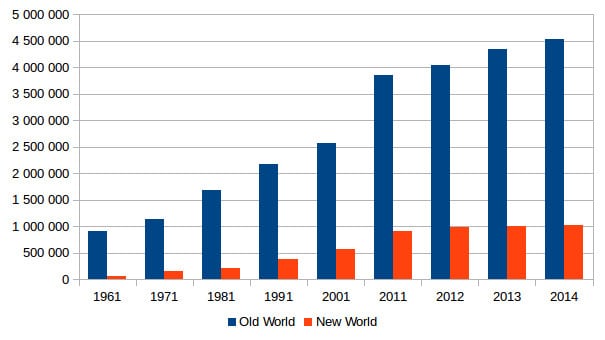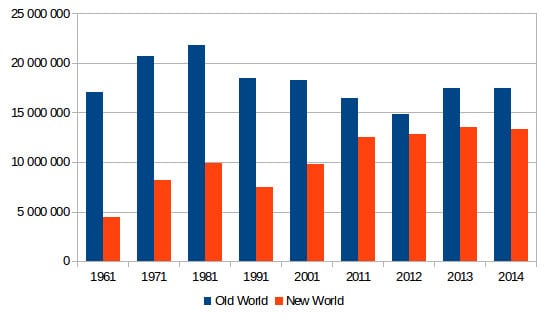New World… these words reminds me of the Age of Discovery, to sails moving into the wind, to the smell of the sea or if you are more a Sci-Fi person to the travels of the spaceship Enterprise that goes where no man has gone before.
But not today. Today, I will not speak about old times or future times or about games but only about drinks and I will invoke another drink to allow you to better understand what I mean : wine. New World wines are wines that are produced outside of the traditional (ie historical) wine-growing areas of Europe and the Middle-East. The questions are “is there a New World tea question?” and if yes, are there any ideas to take from the wine industry?
As he already did several times without knowing it, a fellow blogger inspired me to move this topic on top of my to-do list with his tasting sessions from teas coming from strange places and done in “strange” ways. So thank you Lazylitteratus.
A preliminary remark is that Old World and New World mean different things depending on whether we are in the wine or the tea industry.
Regarding the definition of what an Old World tea is, I just looked at all the producing countries according to the Food And Agriculture Organization of the United Nations (FAO) and classified them.
Here is a list of what I took into account in the Old World category (obviously, this is when you are more than welcome to shoot at myself and tell me that I am wrong):
|
Bangladesh |
China, Mainland |
||
|
China, Taiwan |
India |
Indonesia |
Japan |
|
Kenya |
Malawi |
Mozambique |
Portugal |
|
Republic of Korea |
Sri Lanka |
Union of Soviet Socialist Republics |
Zimbabwe |
The Old World in 1961
My criteria were twofold: first, there had to be before the beginning of the 20th Century some documented growing of tea going on in this country and when I had some doubts, I looked at their production in 1961 (first year reported in the FAO database) and if the production was non-existent or really low, I dropped them off the list.
Obviously since the world has a little changed between 1961 and 2014 (last year available for the FAO statistics), I had to make some change following the fall of the former USSR.
|
Bangladesh |
China, Mainland |
China, Taiwan |
|
|
Georgia |
India |
Indonesia |
Japan |
|
Kenya |
Malawi |
Mozambique |
Portugal |
|
Republic of Korea |
Russian Federation |
Sri Lanka |
Zimbabwe |
The Old World in 2014
Now that I have this list, what is the value of these two productions? In other words, is there anything to talk about?
Tea production in tonnes (source FAO)
I decided not to display every year but every 10 years apart from the last years which are much more interesting to see what happened in the last years.
And as you can see, there is something interesting going as over the last 14 years, the New World production has doubled to reach around 1,000,000 tons pro year, which is something that begins to count but is still far from the Old World production that over the same time period also increased by some 2,000,000 tons.
It is not that big yet but there is something going on and as some of you might have already tasted, there is something interesting going on in the tea world.
The situation is not really the same in the wine industry as illustrated in the graphic below.
Wine production in tonnes (source FAO)
I know that looking at wine production in tonnes can seem strange but this is the only unit they have. Perhaps it is easier to calculate?
But let’s go back to our topic. As seen, both the production and the weight of the New World vs the one of the Old one are on a total different level as in the tea industry. Probably because the history of this “fight” goes back way before that or because growing grapes and making wine is easier as making tea (I am just kidding)?
However, if we look back at the overall picture of the wine industry and how the New World wines managed to find a place under the sun when they were first considered as inferior wines, there are some things that could path the way for more developments in the tea industry.
This will be what I will do in my next article.

